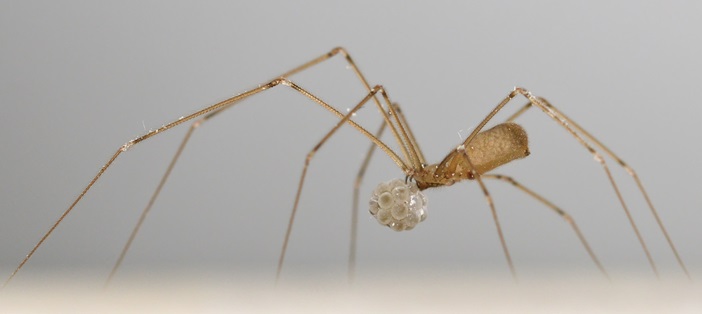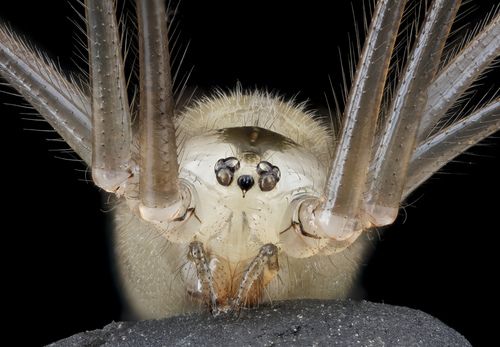My wife and I were moving a pop-up tent from our garage for a neighborhood yard sale this summer when I noticed a good-sized long-legged spider crawl up the wall in response to our rummaging. I was fascinated and grabbed my phone to document it for posterity; my wife was less impressed.
The spiders in question have enough common names for six organisms. They are called “cellar spiders” and “house spiders” for where we find them, “carpenter spiders” for reasons unknown to me, and most confusingly, “daddy long legs spider” for obvious reasons.

There’s an entirely different arachnid group called “daddy long legs” or harvestmen that are not true spiders and can easily be distinguished by their single egg-shaped body segment instead of the spider’s two. And crane flies that look like mosquitoes on steroids, are often called “daddy long legs flies” compounding the confusion.
Regardless of name, aside from humans and our pets, long-bodies cellar spiders (Pholcus phalangioides) are the most commonly observed animals in our homes. How do I know? There’s an online iNaturalist project called “Never Home Alone: the Wild Life of Homes” with contributions from more than 5,000 observers. Collectively they have documented nearly 60,000 invertebrates in homes and other buildings, and you guessed it, cellar spiders are number one.
Cellar spiders are delicate creatures with long legs. The leg joints are often a darker brown than their legs giving them a rather knobby kneed appearance.

Despite the “cellar” portion of their moniker, you may find them in any room that provides an undisturbed corner. If you have found a messy web where your wall meets the ceiling, the chances are high that a cellar spider was the builder. While you might not consider the web an architectural wonder, it does the job of capturing the spider’s invertebrate prey. And when it comes up a little short, cellar spiders are not above giving the web a good shake to increase the chances that a struggling fly will get tangled. And tangling is important, because unlike the silk in many spider webs, cellar spider silk is not sticky. Perhaps all that shaking is akin to setting the hook at your favorite fishing spot?
Cellar spiders also use shaking as a defense mechanism. If a predator approaches a cellar spider in its web, it may start shaking at a speed that approaches a buzzing vibration. The rapid movement makes it harder for the predator to focus on the spider and can be an effective way to avoid becoming lunch.
What, you may wonder, are these spiders lunching on in your home or mine? True flies (Diptera) are high on the menu: house flies, gnats, fruit flies, and mosquitoes are all well within the size range that these spiders can handle. They hang upside down by their webs waiting for some fly or other invertebrate to blunder into their silky mess. And once entangled, the spider bites them, injecting a cocktail of toxins to immobilize its prey before wrapping it in silk and then eating at leisure.
All is not just kill and eat however in a cellar spider’s life. Common on the cellar spider’s meal plan – are other cellar spiders. When prey is in short supply, it’s every spider for him or herself and cannibalism increases. And because these spiders also tend to invade the webs of their peers, caution is essential because both invader and resident spider are at risk of a silk-wrapped end. Some spider species can size up their opponents using chemical signals in the web before attempting a web invasion and retreat if the resident has a size advantage, but the long-bodies cellar spider lacks this system and throws caution to the wind ignoring resident size and just going for it.
Even spider romance comes with risks. When a male spider approaches a female, there is every chance that he will become his chosen one’s next meal. And if he happens to be smaller than the female, his chances of a quick transition from hopeless romantic to hapless meal are high indeed!
But when all goes well in the mating department, the female will lay up to 60 eggs in an egg sack that she carries in her mouth for about three weeks. When her spiderlings hatch, she will guard them for several days before they disperse and make their independent ways in the world. Mother spiders can recognize their offspring and make exceptions to their cannibalistic ways for their children. Her children however take sibling rivalry to the extreme and are perfectly willing to hunt down some brother or sister tartare.
In a home free of toxic insecticides, cellar spiders top the food web and are completely harmless to you and to me. And even if they are not your favorite house guests, they are quietly providing pest control services for free and may be worth bypassing with the feather duster. I hope you’ll agree there’s a lot more to these leggy neighbors than a bunch of dusty cobwebs in the corner.
Declan McCabe is a professor of biology at Saint Michael’s College. His forthcoming book, Turning Stones: Discovering the Life Of Water is available for pre order through Down East Books at DownEastBooks.com or where ever you find your books.


Comment here